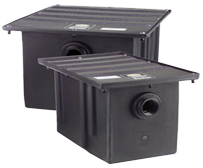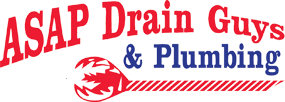
A commercial grease trap doesn’t work by magic — it needs regular cleaning and maintenance. All too often they’re not given the full attention they deserve until there’s a problem such as a disruptive drain backup or a failed inspection and fine.
The Problem
Too much FOG (fats, oils and grease) going down the drain sooner or later causes more problems than just back-ups and clogs. They can foul your septic tank, clog city sewer lines, overload treatment plants, and pollute the environment. So a grease trap or grease interceptor is required for most businesses involved in preparing or serving food. Some homeowners even opt for a grease trap or interceptor to solve ongoing drain problems.
The Solution
At their most basic these devices are tanks with inlet and outlet pipes along with baffles in between to slow the flow. Food solids sink (filling from bottom towards the top), FOG rises and hardens (filling from top towards the bottom), and waste water flows on through. They range in size from a few gallons to 10,000 gallons and more, and can be made of cast iron, concrete, fiberglass, plastic, or stainless steel. Polyethylene is generally preferred for smaller traps as it neither corrodes nor becomes brittle over time. Smaller units are often placed right at the source of food waste, such as underneath a 3-compartment sink in commercial kitchens. Commercial grease traps of 1,000 gallons or more are all but universally placed underground and require a special foundation to handle the weight.
Commercial Grease Trap Cleaning and Maintenance
A full trap no longer serves its purpose and lets harmful fats, oils and grease flow into the sewer system. They also pose serious health issues, indoors and out. So laws, codes, and ordinances require that a commercial grease trap or interceptor be cleaned at least every three months. To meet EPA requirements grease trap maintenance includes measuring and recording the amount of grease and sludge present before cleaning.
Cleaning basically involves opening the lid, inspecting and measuring wastes, and removing grease and solids. Additional grease trap repair and maintenance typically involve replacing gaskets and screens.
From a practical standpoint if you manage a busy kitchens or restaurant you need to have your grease trap cleaned whenever grease and sludge occupy more than 25% of the tank volume. It’s also recommended to have annual grease trap pumping performed annually. This completely removes all FOG, water, and settled debris and allows a thorough inspection of the trap. It’s also a good idea whenever there’s a blockage and whenever foul odors develop.
TIP: Grease trap clogs are not handled the same way as drain and sewer clogs. Do not use hoses, wires, or a drain snake in an attempt to clear a blockage. Nor should you use solvents or heat pipes, especially if you have a plastic or fiberglass trap.
ASAP Drain Guys & Plumbing can assist you with all of your commercial grease trap needs. Contact us at your convenience.


